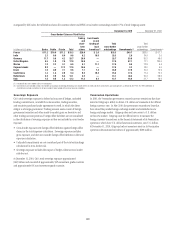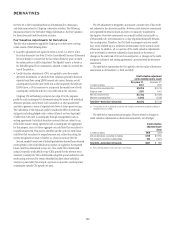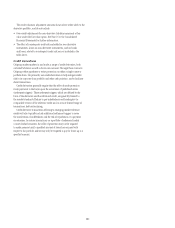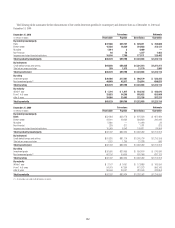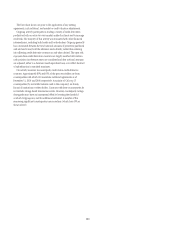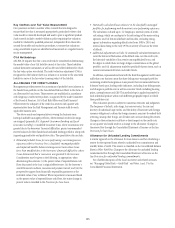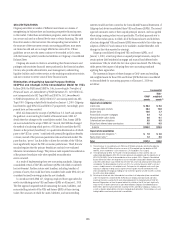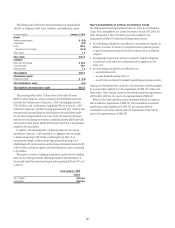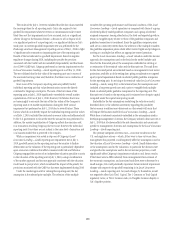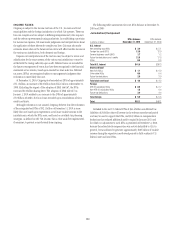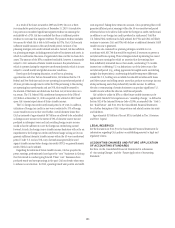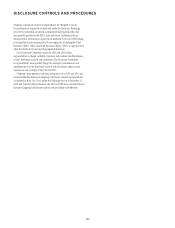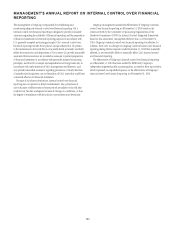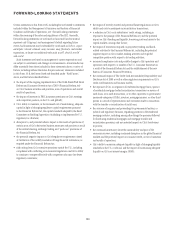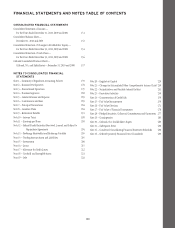Citibank 2010 Annual Report Download - page 141
Download and view the complete annual report
Please find page 141 of the 2010 Citibank annual report below. You can navigate through the pages in the report by either clicking on the pages listed below, or by using the keyword search tool below to find specific information within the annual report.139
The results of the July 1, 2010 test validated that the fair values exceeded
the carrying values for all reporting units. Citi is also required to test
goodwill for impairment whenever events or circumstances make it more
likely than not that impairment may have occurred, such as a significant
adverse change in the business climate, a decision to sell or dispose of all
or a significant portion of a reporting unit, or a significant decline in Citi’s
stock price. An interim goodwill impairment test was performed for the
Brokerage and Asset Management reporting unit as of May 1, 2010 in light
of significant sales transactions impacting the size of the reporting unit.
Results of the test indicated no goodwill impairment. Based on negative
regulatory changes during 2010, including the penalty fee provision
associated with the Credit Card Accountability Responsibility and Disclosure
Act of 2009 (CARD Act), Citigroup performed an interim impairment test for
its Local Consumer Lending—Cards reporting unit as of May 31, 2010.
The test validated that the fair value of the reporting unit was in excess of
the associated carrying value and, therefore, that there was no indication of
goodwill impairment.
Since none of the Company’s reporting units are publicly traded,
individual reporting unit fair value determinations cannot be directly
correlated to Citigroup’s stock price. The sum of the fair values of the
reporting units at July 1, 2010 significantly exceeded the overall market
capitalization of Citi as of July 1, 2010. However, Citi believes that it was
not meaningful to reconcile the sum of the fair values of the Company’s
reporting units to its market capitalization during the 2010 annual
impairment test performed on July 1, 2010 due to several factors. These
factors, which do not directly impact the individual reporting unit fair values
as of July 1, 2010, included the continued economic stake and influence held
by the U.S. government in Citi at the time the annual test was performed. In
addition, the market capitalization of Citigroup reflects the execution risk
in a transaction involving Citigroup due to its size. However, the individual
reporting units’ fair values are not subject to the same level of execution risk
or a business model that is perceived to be complex.
While no impairment was noted in step one of Citigroup’s Local
Consumer Lending—Cards reporting unit impairment test at July 1,
2010, goodwill present in the reporting unit may be sensitive to further
deterioration as the valuation of the reporting unit is particularly dependent
upon economic conditions that affect consumer credit risk and behavior.
Citigroup engaged the services of an independent valuation specialist to assist
in the valuation of the reporting unit at July 1, 2010, using a combination
of the market approach and income approach consistent with the valuation
model used in past practice, which considered the impact of the penalty fee
provisions associated with the CARD Act that were implemented during 2010.
Under the market approach for valuing this reporting unit, the key
assumption is the selected price multiple. The selection of the multiple
considers the operating performance and financial condition of the Local
Consumer Lending—Cards operations as compared with those of a group
of selected publicly traded guideline companies and a group of selected
acquired companies. Among other factors, the level and expected growth in
return on tangible equity relative to those of the guideline companies and
guideline transactions is considered. Since the guideline company prices
used are on a minority interest basis, the selection of the multiple considers
the guideline acquisition prices which reflect control rights and privileges in
arriving at a multiple that reflects an appropriate control premium.
For the Local Consumer Lending—Cards valuation under the income
approach, the assumptions used as the basis for the model include cash
flows for the forecasted period, the assumptions embedded in arriving at
an estimation of the terminal value and the discount rate. The cash flows
for the forecasted period are estimated based on management’s most recent
projections available as of the testing date, giving consideration to targeted
equity capital requirements based on selected public guideline companies
for the reporting unit. In arriving at the terminal value for Local Consumer
Lending—Cards, using 2013 as the terminal year, the assumptions used
included a long-term growth rate and a price-to-tangible book multiple
based on selected public guideline companies for the reporting unit. The
discount rate is based on the reporting unit’s estimated cost of equity capital
computed under the capital asset pricing model.
Embedded in the key assumptions underlying the valuation model,
described above, is the inherent uncertainty regarding the possibility
that economic conditions may deteriorate or other events will occur that
will impact the business model for Local Consumer Lending—Cards.
While there is inherent uncertainty embedded in the assumptions used in
developing management’s forecasts, the Company utilized a discount rate at
July 1, 2010 that it believes reflects the risk characteristics and uncertainty
specific to management’s forecasts and assumptions for the Local Consumer
Lending—Cards reporting unit.
Two primary categories of events exist—economic conditions in the
U.S. and regulatory actions—which, if they were to turn out worse than
management has projected, could negatively affect key assumptions used in
the valuation of Local Consumer Lending—Cards. Small deterioration
in the assumptions used in the valuations, in particular the discount-rate
and growth-rate assumptions used in the net income projections, could
significantly affect Citigroup’s impairment evaluation and, hence, results.
If the future were to differ adversely from management’s best estimate of
key economic assumptions, and associated cash flows were to decrease by a
small margin, Citi could potentially experience future material impairment
charges with respect to the goodwill remaining in its Local Consumer
Lending—Cards reporting unit. Any such charges, by themselves, would
not negatively affect Citi’s Tier 1 Capital, Tier 1 Common or Total Capital
regulatory ratios, or Tier 1 Common ratio, its Tangible Common Equity or
Citi’s liquidity position.


